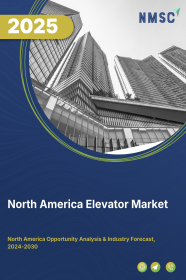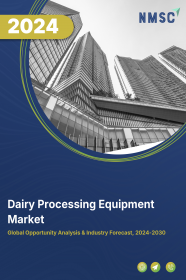
North America Elevator Market by Type (Passenger elevator, Freight elevator and Others), by Technology (Traction and Hydraulic), by Service (New Installation, Maintenance and Modernization), by Capacity (Less than 1500 kg, 1500 to 2500 kg, 2501 to 4000 kg and More than 4000 kg) by Speed (Less than 1 M/S, Between 1 to 4 M/S and More than 5 M/S), by Deck type (Single Deck and Double Deck) and Others- Opportunity Analysis and Industry Forecast, 2024 –2030
Industry: Construction & Manufacturing | Publish Date: 15-Feb-2025 | No of Pages: 162 | No. of Tables: 123 | No. of Figures: 88 | Format: PDF | Report Code : CM1603
US Tariff Impact on North America Elevator Market
Trump Tariffs Are Reshaping Global Business
Market Definition
The North America Elevator Market size was valued at USD 24.38 billion in 2023, and is predicted to reach USD 38.56 billion by 2030, at a CAGR of 5.7% from 2024 to 2030. The elevator market represents a dynamic sector encompassing the design, manufacturing, installation, and maintenance of elevator systems. From conventional traction elevators to cutting-edge smart solutions, this market offers a diverse array of vertical transportation choices customized to suit the distinct requirements of various buildings and infrastructure projects. Stakeholders within the elevator market include manufacturers, suppliers, contractors, architects, building owners, and facility managers.
Manufacturers continuously innovate to enhance elevator performance, safety, and sustainability, while suppliers provide critical components and materials necessary for system construction. Additionally, sustainability considerations, including energy efficiency and material recyclability, are increasingly integral to elevator design and operation. They align with broader environmental objectives and sustainable building practices. Thus, the elevator market is a cornerstone of vertical mobility as elevators enhance functionality, accessibility, and sustainability within buildings and urban landscapes worldwide.
Presence of Key Market Player Drives the Growth of the Market
The elevator market in North America is experiencing significant growth, driven by key players like Otis Worldwide Corporation, who are spearheading innovation with cutting-edge solutions. Leveraging advanced technologies such as digital elevator systems and predictive maintenance platforms, these industry leaders are revolutionizing the landscape of vertical transportation. By focusing on enhancing operational efficiency and sustainability, these solutions address the growing demands of urbanization and modern infrastructure in North America. As cities continue to expand and evolve, the need for efficient and eco-friendly vertical mobility solutions becomes increasingly imperative. Through their innovative offerings, companies like Otis are not only meeting these demands but also setting new standards for safety, reliability, and convenience in the elevator industry. This commitment to innovation and sustainability is a key driver propelling the growth of the elevator market in North America, positioning the region as a hub for technological advancements and transformative solutions in vertical transportation.
The Surging Construction Industry Raises the Demand for the Market
The upsurge in building and construction endeavours stands as a primary driver fuelling the expansion of the elevator market. As urbanization continues to reshape the North America landscapes, the demand for vertical infrastructure such as high-rise buildings, skyscrapers, and mixed-use developments is on the rise. This trend is particularly pronounced in developing economies where rapid urbanization and population growth necessitate inventive solutions for accommodating dense urban populations. Consequently, the construction industry is witnessing a surge in ambitious architectural ventures that redefine city skylines and urban environments. Within these mounting edifices, elevators assume a crucial role as indispensable channels of vertical mobility.
They efficiently ferry occupants and goods between floors, ensuring seamless access to various amenities, residences, offices, and leisure spaces. elevators enhance convenience and optimize space utilization within these tall structures, maximizing the value of vertical real estate. Moreover, the emergence of mixed-use developments underscores the versatile nature of elevators, seamlessly connecting residential, commercial, and retail spaces within a cohesive complex, thereby enhancing accessibility and functionality. As construction activity escalates to meet the demands of urbanization, elevators emerge as pivotal elements of modern infrastructure, further propelling the growth trajectory of the elevator market.
The High Initial Cost Related to The Market Hinders the Growth of the Market
The significant expenses tied to elevator installations, maintenance, and upgrades are notable factors hindering market growth. The initial investment required for installing elevator systems, especially in buildings not originally designed for such infrastructure, can impose a considerable financial burden on building owners and developers. Furthermore, ongoing costs related to maintenance contracts, which involve regular inspections and repairs, contribute to overall ownership expenses. Additionally, the need for modernization to comply with updated safety standards and improve energy efficiency further compounds the financial strain. These expenditures can be particularly challenging for building owners in regions with limited financial resources or older buildings where retrofitting elevators is complex and costly. As a result, the heightened costs associated with elevators restrain market expansion, impacting growth prospects across various regions.
The Adoption of AI-Powered Predictive Elevator Maintenance Offers an Opportunity
AI-driven predictive elevator maintenance presents a lucrative opportunity in the elevator industry by harnessing AI to revolutionize maintenance and management practices. By analyzing data from elevator sensors, AI algorithms can proactively identify maintenance needs, thereby minimizing downtime and maximizing elevator uptime. This approach extends the lifespan of elevator components, enhances safety by preventing unexpected breakdowns, and optimizes resource allocation, resulting in significant cost savings for elevator companies. Moreover, dependable and well-maintained elevators contribute to heightened user satisfaction, enhancing the overall experience for building occupants and visitors. Embracing AI-driven predictive maintenance allows elevator companies to stay competitive and deliver superior service quality amidst a rapidly evolving market landscape.
The U.S. Holds the Dominant Market Share in North America Elevator Market
In 2023, the U.S. elevator market experienced significant growth, reaching a valuation of USD 19.4 billion, with projections indicating a promising trajectory towards USD 29.0 billion by 2030. According to the Central Intelligence Agency's data as of 2023, 83.3% of the American population resides in urban areas, with an annual urbanization growth rate of 0.96%. This rapid urban expansion fuels construction activities, infrastructure enhancements, and industrial advancements, thereby amplifying the demand for elevators across various industries and driving market growth.
Furthermore, companies like Otis Worldwide Corporation, a prominent player in the global elevator industry, contribute significantly to market expansion. With a notable presence, Otis has been involved in some of the world's most iconic structures, bustling transportation hubs, and prominent retail destinations. Such market leaders bolster market growth by implementing diverse strategies to enhance their overall market presence, operational efficiency, and customer satisfaction. For instance, in November 2023, OTIS introduced next-generation smart elevator systems, including the Otis Gen360 digital elevator and the 515NPE public escalator, aiming to advance smart city development and enhance building intelligence, accessibility, and sustainability.
Additionally, in June 2023, Otis launched the Otis ONE IoT digital service solution, providing real-time monitoring and predictive maintenance insights for elevators to enhance performance and equipment uptime. These initiatives underscore the industry's commitment to innovation and customer-centric solutions, further driving the growth of the elevator market in the U.S.
Canada to Witness Substantial Growth in the North America Elevator Market
The burgeoning urbanization in Canada stands as a key driver fuelling the growth of the elevator market. In 2023, Canada witnessed a surge in its urban population to 81.9%, with a projected growth rate of 0.95% in the years ahead. This rapid urbanization is spurring demand for various infrastructural developments, industries, and residential buildings, thereby increasing the need for elevators within this sector.
Moreover, global market leaders like TK elevator (TKE) are actively taking steps to strengthen their presence in the Canadian elevator market. Recently, TKE introduced its innovative cloud-based real-time monitoring and predictive maintenance platform, MAX, to the Canadian market. This groundbreaking platform collects comprehensive data on elevator and escalator components, systems, and performance, empowering building owners and property managers to achieve high uptime and operational efficiency.
TKE's strategic move underscores its commitment to providing innovative solutions tailored to the evolving demands of the Canadian market while advancing vertical transportation technology. Additionally, the elevator market in Canada is poised for significant growth, with projections indicating an anticipated market size of approximately USD 5.0 million by 2030. This optimistic outlook highlights the increasing demand for vertical mobility solutions in urban centers across the country.
As urbanization continues to drive population growth and infrastructure development, there is a rising need for efficient and dependable elevator systems to facilitate vertical transportation in high-rise buildings, commercial complexes, and residential towers.
Competitive Landscape
The North America elevator market comprises various market players, such as Schindler, Otis Elevator Company, TK Elevator (TKE), KONE Corporation, Fujitec Co. Ltd, Hyundai elevator Co. Ltd, Mitsubishi Electric Corporation, Toshiba Corporation, Delta Elevators, Schumacher Elevator Company and others.
North America Elevator Market Key Segments
By Type
-
Passenger elevator
-
Freight elevator
-
Others
By Technology
-
Traction
-
Machine Room [MR] Traction
-
Machine Roomless [MRL] Traction
-
-
Hydraulic
By Service
-
New Installation
-
Maintenance
-
Modernization
By Capacity
-
Less than 1500 kg
-
1500 to 2500 kg
-
2501 to 4000 kg
-
More than 4000 kg
By Speed
-
Less than 1 M/S
-
Between 1 to 4 M/S
-
More than 5 M/S
By Deck Type
-
Single Deck
-
Double Deck
By Designation Control
-
Smart
-
Conventional
By Door Type
-
Automatic
-
Manual
By Application
-
Residential
-
Commercial
-
Industrial
By Country
-
U.S.
-
Canada
-
Mexico
Key Players
-
Schindler
-
Otis Elevator Company
-
TK Elevator (TKE)
-
KONE Corporation
-
Fujitec Co. Ltd
-
Hyundai elevator Co. Ltd
-
Mitsubishi Electric Corporation
-
Toshiba Corporation
-
Delta Elevators
-
Schumacher Elevator Company
REPORT SCOPE AND SEGMENTATION:
|
Parameters |
Details |
|
Market Size in 2023 |
USD 24.38 Billion |
|
Revenue Forecast in 2030 |
USD 38.56 Billion |
|
Growth Rate |
CAGR of 5.7 % from 2024 to 2030 |
|
Analysis Period |
2023–2030 |
|
Base Year Considered |
2023 |
|
Forecast Period |
2024–2030 |
|
Market Size Estimation |
Billion (USD) |
|
Growth Factors |
|
|
Countries Covered |
3 |
|
Companies Profiled |
10 |
|
Market Share |
Available for 10 companies |
|
Customization Scope |
Free customization (equivalent up to 80 working hours of analysts) after purchase. Addition or alteration to country, regional, and segment scope. |
|
Pricing and Purchase Options |
Avail customized purchase options to meet your exact research needs. |

















 Speak to Our Analyst
Speak to Our Analyst




















